
MAY CONTAIN NUTS

Search Shorpy
SHORPY ART

Framed or unframed, desk size to sofa size, printed by us in Arizona and Alabama since 2007. Explore now.
Join and Share
Ad-Free Shorpy
Shorpy is funded by you. Patreon contributors get an ad-free experience.
Learn more.

Recent comments
- Baldwin 62303
- Baldwin VO-1000
- Cold
- No expense spared
- Tough Guys
- Lost in Toyland
- And without gloves
- If I were a blindfolded time traveler
- Smoke Consumer Also Cooks
- Oh that stove!
- Possibly still there?
- What?!?
- $100 Reward
- Freeze Frame
- Texas Flyer wanted
- Just a Year Too Soon
- WWII -- Replacing men with women at the railroad crossing.
- Yes, Icing
- You kids drive me nuts!
- NOT An Easy Job
- I wonder
- Just add window boxes
- Icing Platform?
- Indiana Harbor Belt abides
- Freezing haze
- Corrections (for those who care)
- C&NW at Nelson
- Fallen Flags
- A dangerous job made worse
- Water Stop
Member Photos
The Shorpy
Print Emporium
Print Emporium
Search Shorpy
Search results -- 30 results per page
- Glazier Stove Works: 1901
- Chelsea, Michigan, circa 1901. "Brass foundry, Glazier Stove Co." Shorpy makes an exciting visit to the stove factory. Detroit ... hauling heavy iron parts. On the weekends could see Mr. Glazier's children and grandchildren playing or begging to ride on those cars. ... Posted by Dave - 10/20/2012 - 10:49am -
![Glazier Stove Works: 1901 Chelsea, Michigan, circa 1901. "Brass foundry, Glazier Stove Co." Shorpy makes an exciting visit to the stove factory. Detroit Publishing Co. View full size.
Elevated tracksI can picture some type of push car like railroad workers used running back and forth between the buildings hauling heavy iron parts. On the weekends could see Mr. Glazier's children and grandchildren playing or begging to ride on those cars. Wonder if it ever happened.
Citizen FrankFrank Glazier was an old-school entrepreneur who combined philanthropy with self-interest, and much of the Chelsea, Michigan he built survives. He got 5 to 10 in Jackson Prison when a 1908 bankruptcy hearing found that his wife had destroyed all his financial records "because they upset" her husband.
He was pardoned in 1912 and died in 1922.
Look, Ma -- no air!That Michigan Central Railroad flatcar is not equipped with automatic air brakes as per the 1893 railroad safety appliance act. It may be restricted to service only within Michigan or could have become a car owned by the Glazier Stove and just used on their private sidings. From the looks of how the load is secured on the deck-I'd say the car is restricted to intra factory use.
Brick by Brick.The brickwork in the arch around the large door is amazing! also are the eight brick 'chimneys' on the structure to the left of the flat car.
Bricks built the modern world in the Victorian Era.
Note the narrow-gauge plant railway on the trestle work.
The Steam Railway flat car from the Michigan Central is of an older pattern, not having air brakes, and is constructed almost all of wood.
The truss rods beneath the car can be tightened with the eye shown to keep the car deck level and straight.
Altho' a poor place to ride on a freight car, this is where a hobo might ride when 'riding the rods', adding scrap lumber to make a platform of sorts.
Vertical 'stake pockets' are mounted along the side of the car to take wooden stakes shimmed in with wedges to hold the load on the car.
Often the tops of the stakes would be tied together across the load with wire for extra strength.
The shaft of the hand brake wheel is bent.
On later flat cars the wheel could be lowered into a round recessed into the timbers in the car deck by moving a U-shaped swivel at the bottom of the shaft.
A Trainman was wise to stand back from the end of a car when being pushed by a locomotive, as a sudden jolt from slack in the car couplings could knock him off balance and down between the rails in front of the car to then get run over.
The temptation to stand on the very front and 'show off' is very great, especially when passing a station with patrons out front.
On this car the brake beams and their shoes are outside the trucks, the coupler knuckle has a slot in it to accommodate an adapter link which would allow the car to be coupled to older cars still using link and pin couplings.
The knuckle has a vertical hole thru it for a pin, and the hole is still found on modern cars 100 years later, but, the slot is not.
A red flag on a round wooden staff would be inserted into this hole to signify the car was the end of a train where corner brackets for coal oil marker lamps were not applied.
Don't overlook the weathervane.
Thank You.
Some StreetlightWow: what an unusual bulb in the street light.
[The "bulb" is the globe of a carbon arc lamp. - Dave]
Brightest & Best
Sights and Scenes Along the Michigan Central Line
Chicago Photo-Engraving Company, 1895
The Glazier Stove Company
Manufacturers of the "Brightest and Best" oil and gas stoves, dealers in coal, lumber and builders' supplies. This concern is the largest manufacturing establishment in this vicinity, and one of the largest in State, The business was commenced in a small way by the present proprietor, Mr. Frank P. Glazier, in 1890, and has gradually grown, through careful management, energy and progressive ability until it has assumed its present large proportions, ranking with some of the best manufacturing enterprises of the country. The growth has not been uninterrupted, however, neither has there been any lack of competition to retard its development, but by close attention to business, producing high grade goods and keeping their product and its merits constantly before the public, they have succeeded in not only building up a large trade, but through their own success have contributed to the material welfare of Chelsea. In March, 1895, the entire plant, with the exception of the offices. storage building, and power house, was destroyed by fire. Not disheartened, however, they immediately set to planning for a more extensive and better equipped plant, with its capacity largely increased by modern machinery of the finest quality, and every labor-saving device imaginable for producing better work and more of it than ever attempted before, They employ 120 men nine months in the year, and have facilities for the manufacturing of 300 oil and gas stoves a day.
Their B. & B. trade mark brand, which stands for"Brightest and Best," is considered by the trade to be better in style, quality. finish and durability than any other stoves in the market. Right at this point, we desire to give special recognition to Mr. Glazier. He is a born business man, and is possessed of more than ordinary executive ability, thoroughly reliable in all respects, prompt and honorable in his relations with mankind, affable, enterprising and liberal, and his present prosperous business is a fitting monument to his industry, honesty and integrity. He is prominent in every movement conducive to the welfare and prosperity.
Two years laterFrank Glazier began a downward spiral. Sad ending for a man who did a lot of good.
Detroit, Stove City!In 1880, Detroit was the recognized center of the stove-making industry. But by 1902 the growth of other industries had relegated stove-making to sixth place in Detroit. An industry boom pushed stove-making back into second place by 1922.
In 1860, Jeremiah Dwyer and his brother James started the city's first stove factory at the foot of Mt. Elliott on the near east side, where they prospered and expanded. The stoves could burn wood, coal or coke. Their success attracted others to the area. Gas ranges also became more popular and later replaced the old style stoves. By 1922 Detroit makers built 400,000 stoves worth $10 million in one year.
The industry was dominated in the city by five major firms: The Michigan Stove Company, The Detroit Stove Works, The Penninsular Stove Company, the Art Stove Company, and the Detroit Vapor Stove Company. In later years the Welbilt Company emerged as the last surviving stove company and inherited the giant stove.
From The Detroit News: http://apps.detnews.com/apps/history/index.php?id=198#ixzz0uMQIVV8C
TramwayGreat picture. There's an elevated tramway at left, and it looks like it has wooden rails.
Carbon Arc LampsI have read about these in my 1917 Hawkins Electrical manuals. They usually operated at 50 volts with a draw of 15 amperes or so. A real heat producer! The carbons had to be changed regularly, that is why there is such a long drop wire going to the lamp. You can also see the pullies and cord used to lower the fixture, so that it can be lowered for servicing.
Plant ExpansionBuilding 12 looks brand-new, possibly still under construction. Doesn't look like there's any stove work going on inside.
A different tradeHow much more appropriate if Mr. Glazier had taken up a different line of work. Say, in the manufacture of windowpanes.
Glazier Stove 2003Here is a photo of an Amtrak train passing the Glazier Stove Company in 2003. Photo by Robert Teed.
(The Gallery, DPC, Glazier Stove Works, Railroads)](https://www.shorpy.com/files/images/4a20562a.thumbnail.jpg)
- Glazier Stove: 1901
- Chelsea, Michigan, circa 1901. "Glazier Stove Company, the foundry." 8x10 inch dry plate glass negative, ...
When it's got to be right ... Burn it on a Glazier Stove!
(The Gallery, DPC, Glazier Stove Works, Railroads) ... Posted by Dave - 10/20/2012 - 10:49am -
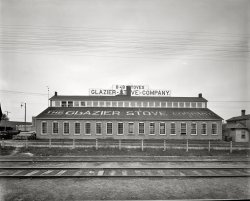
- Factoryville: 1901
- Chelsea, Michigan, circa 1901. "Glazier Stove Company, general view." 8x10 inch dry plate glass negative, ... to do with the manufacturing process, but in fact Glazier Stove Works was owned by Frank Porter Glazier .
Somebody give me a hand Let's grab that handcar and go for a ... Posted by Dave - 10/20/2012 - 10:49am -
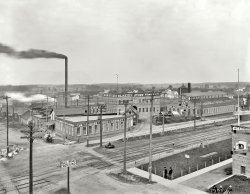
- National Tube Works: 1910
- ... shipped every day for so many years, is still idle.
Glazier Wanted for large Tube and Pipe Factory. Must have own tools and ... Posted by Dave - 07/29/2012 - 1:32pm -
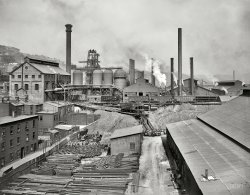
- Heat, Pour, Let Cool: 1901
- Chelsea, Michigan, circa 1901. "Glazier Stove Company molding room." No matter where Shorpy may roam, he ... Busy Bees Most of the foundry workers in this and other Glazier photos are wearing the company work cap, blazoned with its B&B ... company's billhead logo, seen here cropped from an 1893 Glazier purchase receipt.
Re-Roam Soon As a resident of Chelsea, I thank ... Posted by Dave - 10/20/2012 - 10:52am -
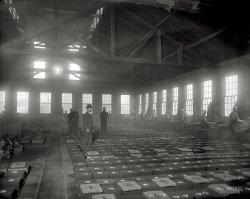
- Stoked: 1901
- Chelsea, Michigan, circa 1901. "Boiler room, Glazier Stove Company." 8x10 inch dry plate glass negative, Detroit Publishing ... of the Stirling Water Tube Safety Boiler , the boiler at Glazier Stove Co was rated at 66 horse-power which is at the smaller end of ... Posted by Dave - 10/20/2012 - 10:49am -
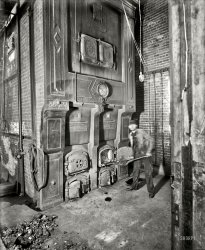
- Meanwhile, Back at the Stove Factory
- Chelsea, Michigan, circa 1901. "Glazier Stove Company, shipping room." Our sixth look behind the scenes at Glazier Stove, whose brand was B&B ("Brightest and Best"). 8x10 inch glass ... to carry a shovel on your shoulder!
(The Gallery, DPC, Glazier Stove Works) ... Posted by Dave - 10/20/2012 - 10:50am -
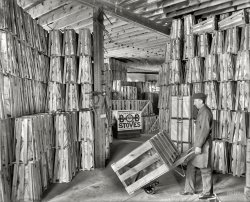
- Stoves to Go: 1901
- Chelsea, Michigan, circa 1901. "Glazier Stove Company tramway." Much as the swallows have their Capistrano, so do Shorpyites eventually find themselves back at the Glazier Stove Works. Detroit Publishing glass negative. View full size.
... beneath that wooden platform.
(The Gallery, DPC, Glazier Stove Works, Railroads) ... Posted by Dave - 10/20/2012 - 10:53am -
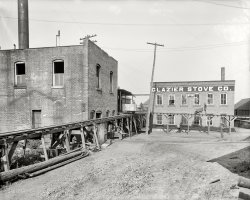
- The Stovemakers: 1901
- Chelsea, Michigan, circa 1901. "Glazier Stove Company -- lamp stove department." Our second glimpse today into the Dickensian workings of Glazier Stove. 8x10 inch dry plate glass negative, Detroit Publishing Co. ... and stove makers right up to today.
(The Gallery, DPC, Glazier Stove Works) ... Posted by Dave - 10/20/2012 - 10:50am -
![The Stovemakers: 1901 Chelsea, Michigan, circa 1901. "Glazier Stove Company -- lamp stove department." Our second glimpse today into the Dickensian workings of Glazier Stove. 8x10 inch dry plate glass negative, Detroit Publishing Co. View full size.
Ironic/electricShould it be ironic foreshadowing that the room where they appear to be making oil lamps is lit up by electric light?
Shorpy Strikes AgainThanks, Dave! Once again, I've learned something new here. When I read the caption, I thought "okay, what the heck is a lamp stove?" It's amazing the things that show up here. A few days back it was charabancs and now lamp stoves.
Turns out these handy devices were heaters, stoves, or lamps or all three at once. Fueled with kerosene, they heated fast and were economical to use. Imagine trying to heat a flatiron on a wood stove; the time and cost would be dreadful, but with a lamp stove, it'd be a snap. there's a short piece about them here. I wonder if somebody still makes them.
Thanks for adding a tiny bit to my appreciation of yesteryear.
Best & BrightestHere are a couple other views, "as intended" and "as is"
In 1901, still a marketFull domestic electrification was still over two decades out, even in cities. In rural areas, it took until the early '50s. The first appliance purchase of a newly-electrified household was invariably an iron, as electric irons could be reliably expected not to put soot on freshly-laundered garments.
And no, I'd never heard of a lamp stove, either. I want one!
Going, going...Strange to see actual manufacturing jobs in America.
[The U.S. of A. is still the biggest producer of manufactured goods on Planet Earth. - Dave]
Nice wiring job.Those little porcelain cleat type insulators holding the wires for the light fixtures are cool!
Good stuff Dave. Keep'em coming.
Patent that!Love the infinitely adjustable lighting fixture, all it takes is a wire, a socket, and a piece of string. Although I think OSHA just had a stroke.
LampStoveAt the time these were made, the automobile was just taking off, and with it the autocamp, where people would stop while traveling. As you can imagine, these early camps didn't have electrical hookups, so this would be a handy, maybe essential item.
Materiel matters. Those are sheets of mica on his right, flame and fireproof natural minerals, used by almost all lamp and stove makers right up to today.
(The Gallery, DPC, Glazier Stove Works)](https://www.shorpy.com/files/images/4a20466a.thumbnail.jpg)
- The Tank Room: 1901
- Chelsea, Michigan, circa 1901. "Glazier Stove Co., tank room." Yet another glimpse of the inner workings at Glazier Stove. 8x10 glass negative. View full size.
Pulley system I ... had been removed to make the join.
(The Gallery, DPC, Glazier Stove Works) ... Posted by Dave - 10/20/2012 - 10:51am -
![The Tank Room: 1901 Chelsea, Michigan, circa 1901. "Glazier Stove Co., tank room." Yet another glimpse of the inner workings at Glazier Stove. 8x10 glass negative. View full size.
Pulley systemI can't seem to figure out how that one pulley in the center appears to be rotating but nothing else is?
Wonder where the main power source is, off to the left out of view perhaps?
How come the three guys nearest in the camera are able to carry on working whilst everybody else is intent on staring at the photographer.
Track LightingExposed, rigid conductors, with movable clamps to pick the power off for each lamp. There really is very little that's truly new, eh?
You used to see a lot of it in Germany, often with the conductors at odd angles, but that's all low voltage. From the bulbs and the other fittings, I'd say this is "house current."
Line shaft drive with control arms.The "main" line shaft is segmented, you can see two control arms (hanging down at about a 60deg angel) they're connected to a "throw out bearing" (note the Y connection at the bearings) these control arms engage/disengage the large driven pulley's. from the "live" main line shaft.
I recall that it took a special eye/touch to "throw" the control arms at the right time or else you got quite a kick off the control arm.
A great picture of old industry!
P.S. they don't make em like they used to!
Fire BucketIn case of fire, fill bucket with 1 gallon of water, throw on flames, repeat as necessary.
[Those fire buckets were generally filled with sand. - Dave]
Clutching at straws@Vintagetvs: clutches maybe? ["I can't seem to figure out how that one pulley in the center appears to be rotating but nothing else is?"]
The lighting......looks to me like standard knob and tube wiring, a venerable and now much-maligned way of doing things that conserved wire and did a good job of dissipating heat. The 'knobs' in this instance are two-conductor ceramic insulators rather than the more common single conductor knob.
It's hard to be certain how the luminaire is tied-in, but I'm betting that the thick spot near the round box is a soldered splice, carefully wrapped with rubberized tape where the insulation had been removed to make the join.
(The Gallery, DPC, Glazier Stove Works)](https://www.shorpy.com/files/images/SHORPY_4a20563a.thumbnail.jpg)
- The Stove Factory: 1901
- Chelsea, Michigan, circa 1901. "Glazier Stove Co., view in yard." It's been ages since we checked in at the ... the first fire you'd start in it.
(The Gallery, DPC, Glazier Stove Works, Railroads) ... Posted by Dave - 10/20/2012 - 10:51am -
![The Stove Factory: 1901 Chelsea, Michigan, circa 1901. "Glazier Stove Co., view in yard." It's been ages since we checked in at the stove works. Detroit Publishing Co. View full size.
FirewoodThere seems to be an awful lot of wood around there for a Stove Factory. Packing crates perhaps?
[See below. - Dave]
Making wood stovesout of wood ??!!
Got Wood?I'm guessing the boards on the rail car will become shipping crates for the stoves.
Single-useThey must be making "wood stoves."
Sorry I couldn't resist.
Chelsea - a Jiffy townChelsea, Michigan apparently never went without heat in the winter - nor did it probably lack for muffins, as it is to this day the home of "Jiffy" muffin mix, put up in those cute little boxes and sold the world around. Did Detroit Publishing Company's camera man point his box toward that venerable plant while in Chelsea?
Coal bunkerLooks like they are storing coal in the building to the left and it is spilling out of what were once windows.
Great view of the brake pipe hose, glad hand and coupler on that old rail car!
EfficiencyThis company was both quite efficient and attentive to their customers's needs. Not only did you get a new stove, you also got the makings for the first fire you'd start in it.
(The Gallery, DPC, Glazier Stove Works, Railroads)](https://www.shorpy.com/files/images/4a20455a.thumbnail.jpg)
- Lord of the Stoves: 1901
- Chelsea, Michigan, circa 1901. "Glazier Stove Company shipping room." Heated by a Round Oak No. 20 stove. ... vu all over again Just when I think we're done with the Glazier Stove Company, you pull us back into it again.
Yet I'd do anything ... my dad's side...his grandfathers.
(The Gallery, DPC, Glazier Stove Works) ... Posted by Dave - 07/08/2014 - 12:57pm -
![Lord of the Stoves: 1901 Chelsea, Michigan, circa 1901. "Glazier Stove Company shipping room." Heated by a Round Oak No. 20 stove. Detroit Publishing glass negative. View full size.
All stove upAnother of my many obsessions of childhood was stove pipes. In the late 40's and into the 50's, you could still see a few stove pipes rising from the back of older houses, usually out of lean-to type rooms (another obsession). I would draw pictures of a room with a pot-bellied stove and make the smoke pipe as complicated and twisting as possible to its exit through the wall or roof. I would have loved this picture, but would have wanted several more bends and elbows before exit.
Deja vu all over againJust when I think we're done with the Glazier Stove Company, you pull us back into it again.
Yet I'd do anything to have one of those old stoves in my kitchen. The utilitarian boxes that we call stoves these days are just boring.
OneJust had to continue the Tolkien reference:
One stove to heat them all and in the darkness shine for them.
Round OakRound Oak stoves were manufactured in my hometown of Dowagiac, in SW lower Michigan. Both sides of my family have history with Round Oak: great-grandfather on my mom's side managed the foundry, and his brothers worked in various administrative positions; both great-grandfathers on my dad's side were Polish immigrants who worked in the factory. Both of my grandfathers worked at Round Oak as well. I wonder where this particular stove ended up. They are quite collectible these days.
[If your dad is like most people, he would have had four great-grandfathers. - Dave]
Both of MY great-grandfathers on my dad's side...his grandfathers.
(The Gallery, DPC, Glazier Stove Works)](https://www.shorpy.com/files/images/4a20469a.thumbnail.jpg)
- Capitalist Tools: 1901
- Chelsea, Michigan, circa 1901. "Glazier Stove Company, machine room." 8x10 inch dry plate glass negative, ... the pile of sheet metal and crate of stamped parts.
Glazier fancied himself quite the magnate and he dabbled/interfered heavily in ... bankruptcy and embezzlement cases which eventually landed Glazier in jail for a few years until he was pardoned for ill-health; he lived ... Posted by Dave - 03/05/2017 - 9:02pm -
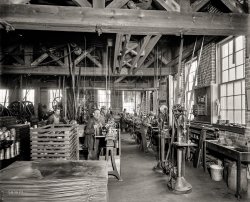
- From Scratch: 1901
- Chelsea, Michigan, circa 1901. "Glazier Stove Company. Moulding room." By the time we're done with this series, ... Stay out of the stove foundry.
(The Gallery, DPC, Glazier Stove Works) ... Posted by Dave - 10/20/2012 - 10:52am -
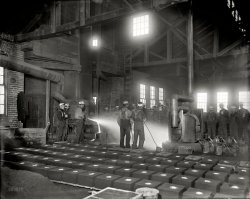
- Stove-Cam: 1901
- Chelsea, Michigan, circa 1901. "Glazier Stove Company, general view." In the four years since our last visit ... for crating up the stoves or what?
(The Gallery, DPC, Glazier Stove Works, Railroads) ... Posted by Dave - 04/28/2014 - 11:06am -
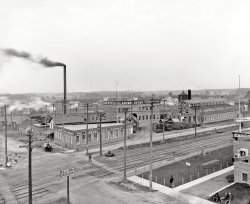
- A Hot Mess: 1901
- Circa 1901. "Glazier Stove Company, brass foundry, Chelsea, Michigan." Our umpteenth look at ... for getting into the building.
(The Gallery, DPC, Glazier Stove Works, Railroads) ... Posted by Dave - 09/23/2014 - 12:38pm -
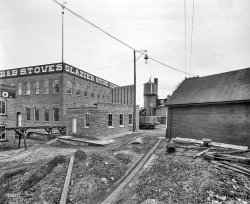
- Bricks and Mortar: 1901
- Chelsea, Michigan, circa 1901. "Glazier Stove Company -- an adjacent building." The stove empire seems to ... it almost wasn't worth it.
(The Gallery, DPC, Glazier Stove Works, Railroads) ... Posted by Dave - 10/20/2012 - 10:56am -
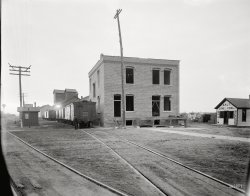
- The Shipping News: 1900
- ... Nice clean and shiny stove ! Must have got it from Glazier Stove Works!
Shipshape indeed! This is a nicely appointed cabin ... Posted by Dave - 07/08/2014 - 1:01pm -
![The Shipping News: 1900 Circa 1900. "Cabin of pilot boat No.2, New York." 8x10 inch dry plate glass negative, Detroit Publishing Company. View full size.
Fred MertzSo that's what he did before he got hitched to Ethel.
ShipshapeNice clean and shiny stove ! Must have got it from Glazier Stove Works!
Shipshape indeed!This is a nicely appointed cabin -- I wonder what the boat looks like from outside. There's carving in the overhead beams, a skylight, and what seems like varnished cabinetry along the sides. Note the curve of the berths along the ship's side and the lockers for pillows and bedclothes (maybe personal items for the pilots, also -- I interpret this as the officers/pilots' quarters, with the ship's crew berthed elsewhere).
It might be a rather old vessel -- maybe even a schooner? I'm suggesting this based on the layout of the cabin, about the same as on Gloucester schooners of the period, and the cabin sole having a patterned linoleum or something like it with something else on top of it -- could it be carpeting? that also looks rather worn.
The stove seems like a later addition. Note the wonderful little wire shrouds with turnbuckles to hold it in place -- were they added after a disastrous roll that pitched hot coals all over the deck, permanently defacing the linoleum, and put out after a terrifying 20 minutes with everyone drafted into a bucket brigade?
[Below, the outside of the pilot boat, which generally are relatively small craft that take harbor pilots out to large ships about to dock. - Dave]
Squared awayAs snug as a bug in a rug. Cozy.
Stove partsThis is a bit of a tangent, but I've been trying to figure something out for years and this pic offers hope. Take a look at the ribbed sides inside the stove. We found some cast iron pieces in our 1887 home that are similar and appear to have been subjected to extreme heat.
Do you think they served the same purpose, and what is that purpose? To provide additional thickness and heat dissipation where the coals would be? Also, any ideas about the piece in the second pic?
(The Gallery, Boats & Bridges, DPC)](https://www.shorpy.com/files/images/4a21384a.thumbnail.jpg)























